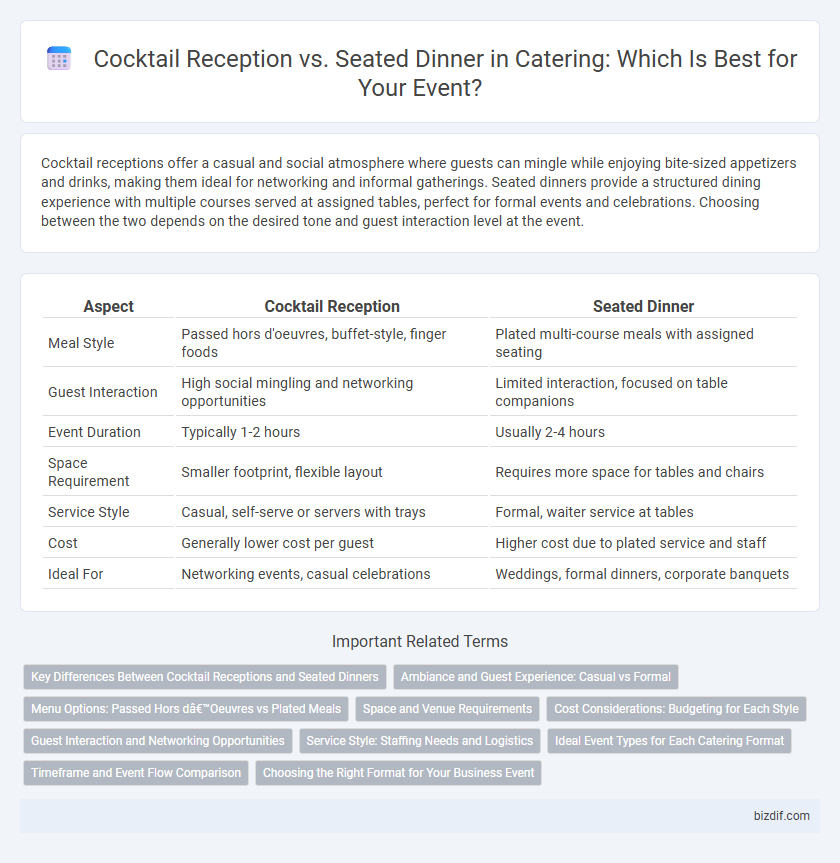Cocktail receptions offer a casual and social atmosphere where guests can mingle while enjoying bite-sized appetizers and drinks, making them ideal for networking and informal gatherings. Seated dinners provide a structured dining experience with multiple courses served at assigned tables, perfect for formal events and celebrations. Choosing between the two depends on the desired tone and guest interaction level at the event.
Table of Comparison
| Aspect | Cocktail Reception | Seated Dinner |
|---|---|---|
| Meal Style | Passed hors d'oeuvres, buffet-style, finger foods | Plated multi-course meals with assigned seating |
| Guest Interaction | High social mingling and networking opportunities | Limited interaction, focused on table companions |
| Event Duration | Typically 1-2 hours | Usually 2-4 hours |
| Space Requirement | Smaller footprint, flexible layout | Requires more space for tables and chairs |
| Service Style | Casual, self-serve or servers with trays | Formal, waiter service at tables |
| Cost | Generally lower cost per guest | Higher cost due to plated service and staff |
| Ideal For | Networking events, casual celebrations | Weddings, formal dinners, corporate banquets |
Key Differences Between Cocktail Receptions and Seated Dinners
Cocktail receptions typically emphasize mingling with a variety of finger foods and passed appetizers, offering a more casual and dynamic social atmosphere compared to seated dinners. Seated dinners focus on a structured, multi-course meal where guests are assigned seats, promoting formal interaction and a paced dining experience. Both formats cater to different event goals, with cocktail receptions favoring networking and movement, while seated dinners prioritize intimate conversation and a complete culinary presentation.
Ambiance and Guest Experience: Casual vs Formal
A cocktail reception offers a casual ambiance with guests mingling and sampling a variety of hors d'oeuvres and drinks, promoting social interaction and a lively atmosphere. In contrast, a seated dinner provides a formal setting where guests enjoy a structured multi-course meal, fostering a more intimate and elegant experience. The choice between the two depends on the desired guest interaction level and event sophistication, with cocktail receptions favoring relaxed networking and seated dinners emphasizing refined dining.
Menu Options: Passed Hors d’Oeuvres vs Plated Meals
Cocktail receptions emphasize variety and interaction through passed hors d'oeuvres, allowing guests to sample multiple small bites like mini quiches, shrimp cocktails, and gourmet sliders. Seated dinners focus on plated meals with curated courses such as filet mignon, herb-roasted chicken, or vegetarian risotto, providing a structured dining experience. Menu options for cocktail receptions prioritize finger foods with bold flavors, while seated dinners highlight balanced, elegant dishes prepared for individual service.
Space and Venue Requirements
Cocktail receptions require flexible, open spaces that can accommodate mingling guests and multiple standing stations, often fitting more people in a smaller area compared to seated dinners. Seated dinners demand larger venues with ample room for tables, chairs, and clear pathways to ensure guest comfort and smooth service. Venue selection must consider layout versatility to optimize flow and experience based on the event's format.
Cost Considerations: Budgeting for Each Style
Cocktail receptions typically cost less than seated dinners due to reduced requirements for plated service staff, tableware, and formal settings. Budgeting for a seated dinner involves higher expenses for multiple courses, china, glassware, and extensive wait staff to ensure timely service. Selecting between these options depends on balancing guest experience preferences with available catering budgets and venue capacities.
Guest Interaction and Networking Opportunities
Cocktail receptions encourage mingling with open spaces and standing arrangements, fostering spontaneous conversations and enhanced guest interaction. Seated dinners provide structured socializing, where guests engage primarily within assigned tables, promoting deeper but limited networking. Event planners prioritize cocktail receptions to maximize networking opportunities, while seated dinners suit formal settings with focused discussion.
Service Style: Staffing Needs and Logistics
Cocktail receptions require fewer servers focused on circulating trays and managing bar stations, enabling more flexible guest movement and social interaction. Seated dinners demand a higher staff-to-guest ratio with dedicated servers for each table to ensure timely food delivery and attentive service. Logistics for cocktail receptions often involve centralized food stations, while seated dinners require coordinated timing and precise placement of courses at each table.
Ideal Event Types for Each Catering Format
Cocktail receptions are ideal for networking events, product launches, and social mixers where guests can mingle freely and sample a variety of small bites and drinks. Seated dinners suit formal occasions such as weddings, corporate banquets, and award ceremonies, offering a structured environment with multi-course meals and assigned seating. Each catering format enhances the event experience by aligning service style with the desired guest interaction and ambiance.
Timeframe and Event Flow Comparison
Cocktail receptions typically last 1.5 to 2 hours, allowing guests to mingle freely and enjoy bite-sized hors d'oeuvres and signature drinks, creating a relaxed, dynamic event flow. Seated dinners usually span 2.5 to 3 hours, featuring a structured multi-course meal with assigned seating that encourages formal interaction and a more ordered progression of service. The choice impacts pacing, guest engagement, and logistics, with cocktail receptions offering fluid socializing and seated dinners providing a curated dining experience.
Choosing the Right Format for Your Business Event
Selecting between a cocktail reception and a seated dinner depends on the event's objectives, guest interaction, and budget considerations. Cocktail receptions encourage networking and casual mingling with finger foods and open bars, ideal for product launches or mixers, while seated dinners facilitate formal discussions and presentations with multi-course meals, suitable for award ceremonies or business meetings. Understanding your audience size, venue capacity, and desired atmosphere ensures the event format maximizes engagement and business outcomes.
Cocktail reception vs Seated dinner Infographic

 bizdif.com
bizdif.com